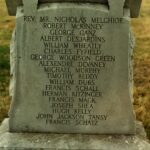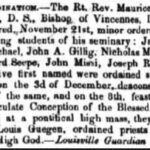I occasionally find names of people who were mentioned in articles, on gravestones, and in books. They are not so much forgotten as they are hidden. That is, years have passed and their stories and lives have been put aside as the times have changed. I was recently drawn to the area known as the “Highlands”, which is near Vincennes. This area was the home of St. Vincent’s Orphanage and was supposed to be the retirement home for Bishop Hailandiere, until he was pursuaded to leave the area after his resignation in 1847. The site is now the home of St. Vincent dePaul parish, in the Diocese of Evansville. Here are two “forgotten” priests who, at one time or another, made their home at thee Highlands and are buried there.
The first person I want to mention is Fr. Nicholas Melchoir. Very little is known about him, except for the fact that he was part of one of the largest ordination classes of his time.
Nicholas Melchoir:
On November 21, 1859 St. Palais gave Minor Orders to six students, none of whom he had brought with him:
John Bernard Seepe, James Andrew Michael, Nicholas Melchior, John p. Gillig, John Michael Missi and Joseph O’Reilly. O’Reilly was dropped from this list when they were ordained subdeacons but Louis Gueguen joined the group for ordination to the priesthood on December 8, 1859. The ceremony on that day was an unparalleled event.It was the first time in the history of the diocese that six priests were ordained on the same day. The bishop himself was greatly encouraged and it seems that he determined to make a strong effort to build up the institution which would solve most of his problems. The ordination was held in the cathedral, whereas all the rest had epen held privately in the seminary chapel. Bede O’Connor OSB, now Chancellor, came up from Jasper, attended the ordination on December 3, the patronal feast of the diocese and preached at the ceremony on December 8. There was, however, an element of tragedy in the occasion since Nicholas Melchior, one of the ordinands, was even then in the last stages of consumption. His family lived in Vincennes, where they had migratated some years before, celebrated his first Mass in St. John church the following Sunday, December 11, 1859 and retired to Highland with Deydier. He died a pious death on March 22, 1860 and is buried in the tiny cemetery near the seminary by the bishop on the following day.
The second person is Fr. John P. Dion. Once again, we turn to a number of sources, including Fr. Alerding’s book, Fr. Gorman’s history and Fr. Thie’s biographies.
John P. Dion
Rev. John P. Dion was born at Drouges, in the Diocese of Rennes, France, on the 22d of July, 1807. At the college of Vitre, of which Rev. M. Jeallsion, a near relative of Bishop Brute, was vice- president, he distinguished himself as a talented and diligent student. Two years and six months he served in the French armies; was promoted to the grade of corporal, but left the army to avoid further promotions. He entered the seminary at Rennes towards the close of 1835. He was ordained priest on May 25, 1839, and celebrated his first mass on the following day, the day on which St. Alphons Liguori was canonized. For six years and two months he labored zealously in the parish of Domagne. During a sickness at the seminary, he vowed to serve on the foreign missions for thirty- three years, if his life were spared him. When Bishop Brute visited France for the last time, Father Dion was so moved by the appearance of the Holy Bishop, that he resolved to follow him to Indiana. However, he could not obtain the permission until, 1843, when Bishop de la Hailandiere succeeded in obtaining his valuable services for his Diocese of Vincennes. He has since always been “in good health and ih good humor,” laboring zealously for God’s glory and man’s salvation. In 1845 he was six months at Lanesville, Harrison county. Until 1848, at St. Thomas and St. Rose, Knox county. From 1848 to 1852, at Lanesville, Harrison county. From 1852 to 1858, at Leopold, Perry county. From 18S!! to 1861, at St. Bernard’s, Harrison county. From 1861 to 1863, at Cannelton, Perry county. From 1863 to 1866, at Leopold, Perry county. From 1866 to 1881, at St. Croix, Perry county. In 1881, for a short time chaplain at the hospital in Evansville. Since 1881, pastor of Highland and chaplain of the Boys’ Orphan Asylum. 1
Then, this from Fr. Thie’s biographies.
Dion, John Peter was born at Drouges, diocese of Rennes, France, on July 22, 1807. Studied in Vitre; served two and a half years in the army and got his discharge as a corporal. In the fall or 1835 he entered the Seminary at Rennes and was ordained there May 25, 1837. Six and a half years he labored there in the parish of Domange. While seriously ill in the seminary he vowed to serve thirty-three years on the foreign missions if his life were spared. He wanted to follow Bishop Brute on his last call for clerical help but oould not get permit till 1843 and then followed Hailandiere to Vincennes in 1845. He was six months at Lanesville, but finding communication with his parishoners difficult, he was given St. Rose and St.Thomas near V1ncennes till 1848. Then again at Lanesville, or rather at Frenchtown and Lanesville till 1852. Leopold 1852 till 1858. He visited St. Croix first time as a station in 1853. on May 3,1855, Holy Cross feast, he said Mass there and named the station St. Croix. In the winter of 1856-1857 the people cut logs for a church and rectory. The church was 32 x 22 feet, finished in 1860. In 1865 the Bishop first time visited St. Croix and gave Dion permit to move his residence from Leopold to St. Croix and then resided there till August 24, 1880. In Lanesville from 1849 till 1862 he built the second church of frame and built the first church at St. Peters, Harrison County, and also attended Frenchtown. He resided at Leopold from 1852-1858; at Frenchtown 1858-1861, and built St. Joseph Church, Crawford County, in l85B, which had been fired in 1857. He was the first resident priest in Frenchtown; 1861-1863 in Cannelton; 1863-1865 in Leopold; 1865-1880 in St. Croix attending St. Joseph in Crawford County, and in 1875 also Frenchtown. (1870-1876 St. Croix, Leopold P.O.) 1875-1881 St. Croix, Westfork P.O.) In June 1880 the Jesuit Missionary, Father Wehinger, preached a mission in St. Croix and Father Dion said adieu to these. parts where he labored nearly all his time in America, on August 24, 1880 , and went for a year as hospital chaplain to st. Mary’s, Evansville, and thence 1881-1896 chaplain at Highland, where he died on April 1, 1896, age eighty-nine years. 2
Fr. Gorman wrote:
A rather detailed description of Father John Paul Dion, who came to the diocese in 1845, has been preserved:
He had a strong voice that could be heard far from the church when preaching. He was of ordinary height and robust in build and spoke English with a strong Frenoh accent. Father Dion’s preaching was unique. Nervously he began his sermon with a loud voice while walking steadily back and forth on the altar platform. At the same time he handled a small piece of string or pencil or some other small object helc bv the fingers of both hands and he trifled with that during the whole sermon. Be made no gestures and seldom looked at the people. . After preaching some five minutes or more in this manner he stopped walking. He then turned towards the audience but looked at the floor in front of him. He now stood and rested firmly on both heels, then raised and lowered the toe-end of eech foot and slightly tapped the platform, then he went through the same action with the other foot. This alternate movement somewhat swayed his body from side to side. This he kept up for a while, about five or more minutes, during which his preaching continued as if nothing else were happening. Then he again walked the platform as in the beginning and follovred that with his foot movement until the close of his sermon. Whenever Father Dion emphasized a statement in his sermon he would repeat the words in a shouting tone, then quickly rise up on tip toe and stamp the platform with both heels. There was sound enough at the climax to rouse anyone to look end take notice. Father Dion’s sermons lasted twenty to twenty-five minutes. In every English sermon Father Dion got stuck several times, for want of a word that he could not recall at the moment. He would hesitate, look at the ceiling above, and dreawl the French word “Cela,” meaning “that is”, several times, making, it sound like “Slaw-Slaw”, and if the illusive word did not soon come to mind he would sav something equivilent to it in French and continue his sermon. 3
As this is being posted on September 17, we want to note that tomorrow, on September 18, 1804, is the anniversary of the birth of Simon P. Lalumiere. He was the “First Priest of Bishop Brute”
Also, last weekend was the 50th anniversary of the Canonization of Saint Elizabeth Ann Seton. She was an important part of our history in Indiana due to the fact that Bishop Brute was her spiritual director for the last 9 years of her life. One would think that Brute’s influence helped to contribute to her holiness – her “sainthood”.
Realizing full well that last weekend was NOT about Simon Brute, but about our first native born saint, I still need to express my disappointment in the fact that the web page dedicated to Saints on their Way had Brute about 5 rows from the top and listed him as:
Fr. Brute (despite the fact that he was a Bishop and one of the first bishops in the “west”) Served in Maryland and Indiana (despite his major role in the life of St. Elizabeth as well as Mount St. Mary’s Emmitsburg and St. Mary’s Baltimore) An Artist (Brute simply enjoyed making sketches)
No mention was made of him being Elizabeth Seton’s spiritual director.

